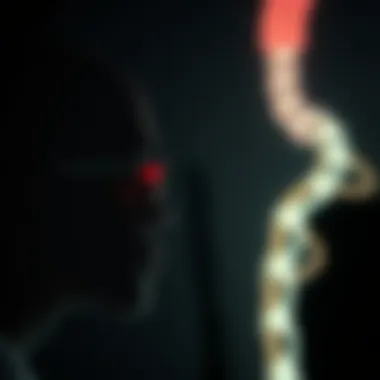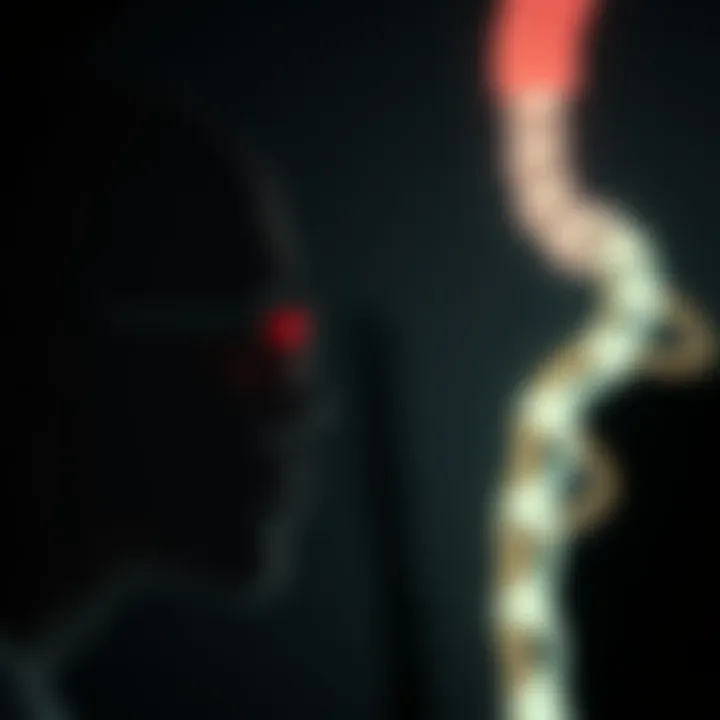Exploring Blacklight: Science and Its Applications


Intro
In the captivating world of geology, the ability to identify rocks and fossils is a skill that can deeply enhance one’s appreciation for the planet's history. With advancements in technology and the increasing popularity of mineral collecting, blacklight has surged to the forefront as a vital tool. This article aims to provide a comprehensive look into the role of blacklight in rock and fossil identification, techniques for collecting, preservation methods, and the geological insights that can be gleaned through careful study.
Rock and Fossil Identification
Understanding how to identify rocks and fossils is essential for any collector or geology enthusiast. The use of blacklight or ultraviolet (UV) light can often reveal characteristics that might not be visible under normal lighting conditions.
Types of Rocks and Fossils
Rocks can be broadly classified into three categories: igneous, sedimentary, and metamorphic. Each type offers unique clues about the Earth’s history. For instance, igneous rocks like granite form from cooled magma, whereas sedimentary rocks like limestone form from accumulated particles and organic materials. Collectively, these rocks can reveal a timeline of geological events. Additionally, fossils, which are remnants of organisms from ancient times, can include everything from dinosaur bones to tiny shells embedded in rock layers.
Characteristics to Look For
When examining rocks and fossils under blacklight, enthusiasts should pay close attention to the following characteristics:
- Fluorescence: Some minerals emit visible light when exposed to UV rays. A classic example is calcite, which can fluoresce bright red.
- Color Changes: Many minerals change color under blacklight, allowing for easier identification. For example, willemite often appears green.
- Patterns and Textures: The unique textures of fossils can be highlighted under blacklight, making it easier to differentiate between similar specimens.
Tools for Identification
The most crucial tool in the field is a proper blacklight. Compact UV flashlights are convenient for fieldwork, whereas larger UV lamps can be used in a lab or home setting. Beyond blacklight, the following tools can also aid in rock and fossil identification:
- Magnifying Glass: Helps to see small details on specimens.
- Field Guidebooks: Reference materials provide valuable information about regional geology.
- Notebook: Keeping records can help in tracking findings and observations.
"Understanding the nuances of rock and fossil identification is more than just a hobby; it's a gateway into the deep history of our planet."
Collecting Tips and Techniques
For those eager to start their collecting journey, having a strategy can make all the difference. Knowledge of local geology and responsible collecting practices is essential for a fruitful experience.
Best Practices for Collecting
- Always obtain permission before digging or collecting on private lands.
- Follow local regulations and guidelines laid out by geological societies.
- Be respectful of the environment, taking care to leave the area as you found it.
Locating Prime Collecting Sites
Successful collectors often frequent areas known for their geological richness. Here are some tips:
- Research geological maps for locations of interest, which often show old quarries, riverbeds, or mountains.
- Join local geology groups on platforms like Reddit or Facebook to discover hidden gems in your area.
- Use online resources such as state geological surveys to find approved local sites for collecting.
How to Safely Extract Specimens
When extracting specimens:
- Use the proper tools, such as chisels, geological hammers, and brushes to avoid damaging the specimens.
- Work gently and carefully, especially with more delicate fossils. Patience is key.
- Always have a plan for transporting your finds safely back home.
Preservation and Display
Once you've successfully collected your rocks and fossils, the next step is preservation to ensure they last for generations to come.
Techniques for Preserving Rocks and Fossils
- Cleaning: Use gentle methods, like soft brushes or water to clean specimens. Avoid harsh chemicals.
- Coating: Some collectors choose to use clear acrylics to seal and protect their finds.
- Documentation: Keeping thorough notes about where and how each specimen was found can greatly enhance its value and historical significance.
Proper Storage Methods
Store your specimens in a cool, dry place. Consider using:
- Acid-free boxes: These help keep the specimens safe from environmental damage.
- Display cases: Protect them from dust and accidental damage while making them visible.
Creative Display Ideas
Displaying your collection doesn’t have to be mundane. Consider these ideas:
- Shadow boxes: Create thematic displays with background stories for each specimen.
- Gallery wall: Frame outstanding specimens to turn a wall into a mini-museum.
Geological Insights
The study of rocks and fossils not only feeds the curiosity of collectors but also provides insights into Earth’s geological processes and history.
Geological Formations and Processes
Understanding how geological formations like plate tectonics or erosion shape our landscape helps collectors appreciate the context of their specimens. For instance, sedimentary layers can indicate ancient environments that were once oceans or forests.


Historical Significance of Rocks and Fossils
Rocks and fossils tell a story of life on Earth, with some specimens dating back hundreds of millions of years. They provide clues about past climates, flora, and fauna, contributing hugely to our understanding of evolution.
Notable Discoveries in the Field
The field of geology is filled with remarkable discoveries. From the first dinosaur fossils found in the 19th century to recent finds of previously unknown species, these discoveries keep expanding our understanding of life throughout Earth’s history. Every rock and fossil has the potential to be a new revelation.
For avid collectors and enthusiasts alike, blacklight serves not just as a tool but as an enlightening gateway into a deeper understanding of geology and mineral collection. Whether you’re unraveling the secrets of a rock specimen or connecting with the ancient life inscribed in fossils, the journey of discovery continues.
Defining Blacklight
The quest to understand blacklight is often perceived as a mere exploration of its physical properties. However, this section highlights its profound importance within the realm of geology and other fields. Defining blacklight encompasses several specific elements including the nature of ultraviolet light, how it differs from visible light, and the various types of blacklights available. Each of these aspects provides a foundation that informs both enthusiasts and collectors about effectively utilizing blacklight in their pursuits.
Nature of Ultraviolet Light
Ultraviolet light (UV) is a fascinating aspect of the electromagnetic spectrum. It occupies a position just beyond the visible light spectrum, with wavelengths ranging from 10 nm to 400 nm. This unique region is where the magic begins, as UV light is invisible to the human eye. Yet, it possesses qualities that can provoke vivid reactions from certain materials.
For example, many minerals exhibit fluorescence when exposed to UV light; they glow in a range of colors, revealing hidden characteristics. Without blacklight, these traits would remain dormant and concealed. This property signals the beginning of appreciation for geological specimens, enhancing overall understanding and interest.
Blacklight vs. Visible Light
When discussing blacklight, one cannot ignore its contrasting relationship with visible light. Visible light is what we see and is comprised of wavelengths between 380 nm and 750 nm. In comparison, blacklight predominantly deals with UV wavelengths. As such, the effects of these two light types can be quite different.
You could say it's like comparing apples to oranges; both can be visually striking, but they serve entirely different functions. Blacklight helps enthusiasts reveal the unseen, while visible light merely illuminates what is already known. This contrast highlights why blacklight is invaluable in the worlds of geology and art authentication, among others.
Types of Blacklight
There are several types of blacklights, each contributing uniquely to the topic at hand. Understanding these variations is crucial for collectors and professionals alike.
Fluorescent Blacklights
Fluorescent blacklights are often the go-to choice for amateurs and experts alike. They operate by using a coating that transforms some of the UV light into visible light. The glow they emit is generally blue-violet and can create stunning visual effects. Their accessibility and cost-effectiveness make them extremely popular in various settings.
A key characteristic of fluorescent blacklights is their ability to cover larger areas, which can be particularly beneficial in fieldwork. However, they do have downsides, such as being bulkier and inferior in terms of energy efficiency compared to newer technologies.
LED Blacklights
LED blacklights represent the modern advancement in the blacklight category. They are compact, energy-efficient, and long-lasting, making them an attractive option for many. The light emitted from an LED blacklight tends to be more directional, therefore enhancing precision when focused on specific objects.
One of the highlights of LED blacklights is their reduced heat output, contributing to safer handling during fieldwork. Nonetheless, their narrow beam can sometimes limit coverage, which might require multiple units for expansive observations.
Mercury Vapor Blacklights
Mercury vapor blacklights have a unique position, historically significant and still in use today. They provide a powerful output and are especially effective in commercial applications. These blacklights often require more care to handle due to mercury's hazards.
Their key advantage is their intense UV output, great for professionals who need high-intensity light for various tasks. However, the downsides include the weight, size, and energy consumption, not to mention the environmental concerns surrounding mercury waste.
In sum, understanding the different types of blacklights equips collectors and enthusiasts with the knowledge needed for effective fieldwork. Each type has its own unique attributes, and knowing when to use each can make a significant difference in the outcomes of mineral or specimen investigation.
The Science Behind Blacklight
The exploration of blacklight is inherently tied to its scientific principles. Understanding the science behind blacklight not only demystifies the mechanism of ultraviolet light but also enhances its applications in various fields. For collectors, grasping these concepts is crucial in order to make informed decisions and employ effective techniques in their endeavors.
Understanding Electromagnetic Spectrum
At the core of blacklight technology lies the electromagnetic spectrum, a continuum of all electromagnetic waves arranged according to frequency or wavelength. This broad spectrum includes visible light, ultraviolet (UV) light, infrared light, and beyond. What sets blacklight apart is its emission of ultraviolet rays, specifically in the UVA range (320-400 nm). Unlike visible light, which we see with the naked eye, ultraviolet light is invisible, providing a unique advantage when examining certain minerals and materials.
In the realm of collecting, understanding the electromagnetic spectrum is vital. For instance:
- UVA Rays: Commonly associated with commercial blacklights, they induce fluorescence in many minerals.
- UVB Rays: These are less commonly found in blacklights but are present in sunlight and can cause skin damage.
- UVC Rays: While they are effective in sterilization, they don’t interest collectors much since they damage materials.
By comprehending this spectrum, collectors can better navigate which types of blacklights are suitable for their specific applications.
Principles of Fluorescence
Fluorescence is a captivating phenomenon where certain materials absorb light at one wavelength and emit it at a longer wavelength. In the context of blacklight, this process is primarily observed with UV light activation. When rocks or minerals are exposed to this special light, their electrons become excited and, upon returning to their resting state, they release energy in the form of visible light.
A few key aspects of fluorescence include:
- Short-lived Emission: The glow seen typically lasts only while the UV light is shining on the specimen. Once the light is removed, the glow ceases, making it a transient yet striking effect.
- Color Variation: Different substances fluoresce in various colors; chalk can glow a bright white, while certain gems might emit vibrant shades ranging from green to red.
- Cultural Significance: In art, fluorescent elements can signify authenticity or help identify forgery in valuable pieces.
For collectors, familiarity with fluorescence not only enhances the aesthetic appreciation of specimens but is a key tool in engaging with potential discoveries.
How Objects Emit Visible Light


The ability of objects to emit visible light under blacklight scrutiny hinges on their chemical composition and structural properties. As mentioned before, the fluorescence process is a direct result of electrons absorbing UV light. Yet, the specific elemental makeup dictates how effective and visually appealing this glow will be.
For instance, certain minerals like willemite are known to emit a greenish glow, while others, like calcite, may show a striking orange hue. In addition to fluorescence, there’s phosphorescence—a delayed emission of light that continues even after the UV light is switched off.
Collectors must be aware that:
- Impurities: Some specimens may not fluoresce due to impurities or lack of reactive elements, which can complicate the identification process.
- Texture and Size: The surface texture or the size of the mineral can influence the intensity of its glow. Larger or rough-surfaced specimens might reflect more UV rays, thereby appearing more vibrant.
- Interaction with Other Elements: Sometimes, the presence of additional minerals can enhance or diminish the fluorescence of a specimen.
Understanding these intricate details allows rock and fossil collectors to not just appreciate their collections more fully but also helps in making significant discoveries.
"Fluorescence transforms the ordinary into the extraordinary, revealing hidden beauty in rocks that would otherwise remain unremarkable."
Applications of Blacklight
The scope of blacklight applications is vast, reaching into various fields and professions where its unique ability to highlight materials through fluorescence is invaluable. Its use transcends mere novelty; it serves as a tool in geology, art authentication, and even safety inspections. Understanding these specific applications is vital as they reveal not only how blacklight enhances our comprehension of materials but also the advantages it offers individuals and industries alike.
In Geology and Mineralogy
Identifying Fluorescent Minerals
Fluorescent minerals react distinctly when exposed to blacklight, making them easily identifiable under certain conditions. This characteristic is particularly beneficial for mineral collectors and geologists seeking to discern specific types that may not be visible under regular light conditions. The ability to reveal hidden properties can transform seemingly dull specimens into vibrant displays of color and sheen, thereby expanding the collector’s knowledge and appreciation.
One of the significant aspects of identifying fluorescent minerals is their diverse range of response to different wavelengths of UV light. For example, calcite and fluorite can exhibit bright hues of red and blue, respectively, when illuminated. This unique feature not only aids in accurate identification but also enhances the educational value for collectors who are keen to learn more about the complexity of mineralogical properties.
However, it's essential to note that not all minerals will fluoresce, and some may even exhibit fluorescence under specific conditions only. This can lead to occasional disappointments if expectations aren't managed. Still, blacklight’s role in identifying these minerals remains a popular pursuit in the field of geology.
Enhancing Collection Displays
Incorporating blacklight into a mineral collection isn't just about identification; it also significantly enhances the visual appeal of display cases. Museums and private collectors alike utilize blacklight displays to vividly showcase specimens that would otherwise go unnoticed in standard lighting. This unique showcasing creates a stunning aesthetic that draws the eye and captivates visitors.
By employing different types of blacklights, collectors can manipulate how minerals are displayed, crafting immersive experiences. For instance, using a combination of fluorescent and LED blacklights allows for diverse effects, illuminating specific aspects of minerals in ways that traditional lighting cannot achieve. This contributes not only to the enjoyment of viewing such specimens but also serves an educational purpose, allowing observers to witness phenomena like fluorescence firsthand, greatly enriching the learning experience.
On the downside, maintaining these displays can require extra effort; blacklights generate noticeable heat, and some minerals may eventually fade under prolonged exposure. Nonetheless, the benefits of capturing exquisite visual effects can overshadow these drawbacks, making blacklight displays a cherished aspect of mineralogy.
In Art Authentication
Blacklight serves as a utility in the realm of art authentication, transforming how collectors and curators validate the legitimacy of valuable pieces. By exposing paintings and artifacts to ultraviolet light, professionals can reveal overpainting, restoration, or forgeries that are otherwise invisible to the naked eye. This process is particularly vital when determining the provenance of works attributed to prominent artists.
For instance, an original painting may be presented alongside a revealed underdrawing when viewed under blacklight, providing valuable insight into the artist's working methods. This not only ensures that art collectors are investing in genuine pieces but also aids in preserving cultural heritage by recognizing and documenting restored works.
However, while blacklight is a valuable ally, it is not a standalone solution for determining authenticity. It should be complemented with other techniques and materials analysis for comprehensive validation.
In Safety and Inspection
The applications of blacklight extend into practical safety inspections, particularly in identifying contaminants or hazards invisible to regular lighting. In scenarios like pest control, fluids, or biological residues can appear fluorescent under blacklight, guiding inspectors in maintaining hygiene standards, especially in food processing facilities.
In addition, blacklight aids in forensic investigations, helping law enforcement to uncover evidence that has been potentially overlooked in conventional light. Biological fluids, for instance — including blood and bodily fluids — can fluoresce, highlighting areas that require further examination.
Yet, like other applications, usage of blacklight in safety inspections does have its limitations. Not all materials react uniformly, and misinterpretation can occur should one depend solely on blacklight without corroborating evidence. Still, its utility as a compelling tool in various inspection scenarios reaffirms its place in professional practices.
Blacklight isn't just a gimmick; it's a gateway to understanding, revealing both the beauty of nature and the intricacies of human creations.
Collecting with Blacklight
Collecting minerals and fossils can be a rewarding endeavor, especially with the help of blacklight. Utilizing blacklight in collection enhances the excitement and helps illuminate hidden features in specimens. It opens a new world where minerals that appear dull in natural light burst into vibrant colors once exposed to ultraviolet radiation. Understanding how to effectively collect with blacklight adds a layer of skill to mineral enthusiasts and enables them to identify unique specimens that may otherwise go unnoticed.
Essential Equipment for Collectors
Types of Blacklights to Use
When it comes to blacklights, not all are created equal. The right choice can make a significant difference in your collecting experience. There are several types of blacklights available, such as fluorescent, LED, and mercury vapor blacklights, each with distinct features.
Fluorescent blacklights are often the go-to choice for collectors, thrice because they emit a considerable amount of UV light and often come in portable forms. These lights are known for their sharp intensity, making them effective in revealing fluorescent minerals quickly. Nonetheless, they can get warm and might have a shorter lifespan compared to LEDs.
LED blacklights, on the other hand, boast energy efficiency and longer life spans. Plus, they come compact and often designed for almost all types of outdoor activities, making them a crowd favorite. Nevertheless, they might not generate the same level of light intensity that can be found in fluorescent options. Lastly, mercury vapor blacklights can have high output but generally are heavier and less convenient to use in the field.
In summary, if your goal is to efficiently spot minerals under varying conditions, considering the above options will help determine what suits best.
Safety Precautions
With great tools comes great responsibility. While blacklights can unveil the beauty of minerals, it is essential to follow safety precautions to protect yourself against potential risks. The glaring strength of UV light necessitates protective measures.
Firstly, wearing UV-blocking glasses is a must. This is particularly crucial if you plan on using blacklights frequently; shield your eyes from prolonged exposure. Additionally, using appropriate skin protection, like long sleeves, can prevent any harmful skin damage.
Another factor to consider is making sure your equipment is well-ventilated if using an intense blacklight setup indoors. Taking these precautions is not just wise but vital, keeping your collection endeavors fun and injury-free.


Field Techniques for Using Blacklight
Best Practices
When collecting in the field using blacklight, it's crucial to adopt best practices to maximize your findings. Timing is key; night time is often the best for blacklight exploration, as ambient light is minimal, allowing you to spot glowing minerals more clearly. Bring along a notebook to record your findings, noting the locations of unique specimens.
Furthermore, exploring rocky terrains can yield surprising discoveries. Being aware of your surroundings and sticking to routes you know well can help you avoid unnecessary risks while navigating rough grounds. By using a blacklight to help identify potential targets, you amplify your chances of arriving at significant finds.
With patient persistence and keen observation, many collectors find success—making the night a canvas for discovery.
Identifying Targets
Identifying suitable targets for collection utilizing blacklight is a fundamental skill for any enthusiast. Some minerals, such as calcite or fluorite, possess remarkable fluorescence properties that can be striking under UV light. You will often find yourself honing the intuitive skill of distinguishing which specimens will likely reveal themselves in outstanding ways when exposed to blacklight.
To enhance your identification process, familiarize yourself with local geological maps. This will give you a deeper understanding of the types of minerals you might come across in different regions. Also, engaging with local collecting groups on platforms like reddit.com or facebook.com can provide insight into recent finds and tips from experienced collectors.
In summary, with the right techniques in mind, blacklight use can indeed transform a mundane hunt into an enlightening adventure. By implementing these best practices and remaining aware of suitable targets, your exploration can lead to treasures waiting for discovery.
Challenges and Considerations
Understanding the challenges and considerations surrounding the use of blacklight is crucial for rock and fossil collectors. While blacklight opens up a fascinating world of fluorescence and mineral discovery, it isn't without its limitations and environmental influences that can affect both the experience and the results one can achieve when collecting.
Limitations of Blacklight
Blacklight is an invaluable tool for revealing the hidden beauty in minerals and fossils. However, it comes with its own set of drawbacks. One of the foremost limitations is that not all minerals exhibit fluorescence under blacklight. For instance, while some calcites may glow vibrantly, others might remain stubbornly mute in the darkness. This lack of universality can lead to frustrations among collectors eager to unveil potential finds that may not react as anticipated.
- Limited Availability of Materials: Some blacklight-reactive minerals can be rare or hard to come by. Collectors may find themselves chasing elusive specimens, leading to both time and financial investment without guaranteed success.
- Calibration Questions: Certain blacklights have varying spectral outputs depending on their design, which can result in inconsistent observations. What appears to shine brilliantly under one light could seem drab under another.
- Health Concerns: Exposure to UV light, albeit low levels, raises health questions. Prolonged use without adequate eye protection can lead to discomfort or potential long-term issues. Hence, safety equipment that filters UV light or protective eyewear should be a standard part of every collector’s kit.
“Blacklight doesn’t just change how we see minerals; it also changes how we collect them, presenting both opportunities and challenges.”
In summary, while blacklight enhances the process of identifying and appreciating minerals, collectors must remain wary of its limitations. It is essential to approach the use of blacklight with a well-rounded understanding of what to expect.
Environmental Factors
Environmental conditions can significantly impact the effectiveness of blacklight during fieldwork. Weather, humidity, and local flora and fauna are just a few of the elements that can affect visibility and the overall success of a collection outing.
- Humidity Levels: High humidity can obscure visibility, making it more challenging to spot fluorescent materials. It’s advisable to choose a day that’s dry and clear, as this will enhance the contrast between fluorescing materials and their surroundings, making them easier to detect.
- Natural Light Pollution: If you’re collecting in an area with lots of artificial light, or even during twilight, it becomes substantially harder to see the effects of blacklight. Darkness enhances the brilliance of fluorescing specimens, so consider planning your collecting trips during moonless nights.
- Flora and Fauna Interference: Certain plants may emit their own fluorescence under blacklight, which can lead to confusion in identifying true mineral specimens. Understanding your surroundings and being able to distinguish between mineral and biological fluorescence is crucial for effective collecting.
Future of Blacklight in Collecting
The future of blacklight in mineral and fossil collecting holds significant promise, building on its current applications and expanding to new frontiers. As the world of geology continues to evolve, with technological advancements paving the way for innovative methodologies, blacklight remains a cornerstone for enthusiasts. This section will delve into how these advancements not only enhance the collecting experience but also consider the broader impacts on the field as a whole.
Advancements in Technology
Recent technological progress has revolutionized the way collectors utilize blacklight. Newer models of LED blacklights are more energy-efficient, providing stronger outputs while consuming considerably less power. This shift not only promotes sustainability but also enhances portability, making it easier for collectors to bring their tools into the field.
Another significant development lies in the creation of specialized blacklight filters and lenses. These tools allow for improved visibility and clarity, enabling collectors to identify minerals and fossils more easily without the clutter and distortion of less sophisticated lights. Additionally, colorimetric advancements mean that different wavelengths can be more effectively targeted, aiding in the discrimination of materials that fluoresce at various spectra.
The integration of smartphone technology into the blacklight domain has also raised the game. With apps designed specifically for collectors, users can catalog their finds in real-time, employing their device's camera to document fluorescence. This combination allows for a seamless enhancement of fieldwork and analysis, making the collecting process more engaging and organized.
Integration with Other Techniques
To maximize the benefits of blacklight, it’s important to recognize its potential when combined with other techniques. For instance, pairing blacklight with photoluminescence analysis offers collectors deeper insight into the authenticity and quality of specimens. This dual approach can help differentiate genuine fossils from imitations, especially in an age where replicas are increasingly common.
Additionally, the synthesis of blacklight with digital scanning technologies has opened yet another promising avenue. By using 3D imaging alongside ultraviolet illumination, collectors can create detailed digital archives of their collections. This not only assists in cataloging but also serves as an invaluable resource for provenance, allowing for greater traceability of finds.
Implementing these combined techniques will certainly enhance the knowledge base among collectors. Providing workshops or conferences focused on these integrative practices could instill a culture of sharing and research, fostering a community committed to ethical collecting and appreciation of geological heritage.
The future of blacklight in collecting does not merely rest on the technology itself, but on how these tools are utilized to inspire a new generation of enthusiasts.
Embracing these developments will not just refine the individual collector's experience but may well reshape the landscape of mineral and fossil collection as a whole.
Closure
In sum, this article navigates not only the fascinating properties of blacklight but also its substantial impact on geology and the art of collecting. Recognizing how ultraviolet light operates can illuminate the darker corners of our understanding—particularly in identifying unique minerals and fossils that otherwise might go unnoticed. This isn't just a technical exploration but a gateway to appreciating the natural world in a much more profound way. Understanding blacklight can equip rock and fossil collectors with essential tools for enhancing their practices and insights, ultimately leading to deeper connections with their specimens.
Summarizing Key Insights
Throughout the examination of blacklight, several pivotal points emerge:
- The Nature of Ultraviolet Light: Understanding its properties sets the stage for its applications.
- Applications Across Fields: From mineral identification to art authentication, blacklight serves many crucial roles.
- Collectors' Advantages: Utilizing blacklight can enhance collection displays and the overall experience of geology enthusiasts.
- Future Directions: Advancements in technology promise greater integration of blacklight with other techniques, thus expanding its utility.
In the realm of geology, being proficient with blacklight can make or break a collection's potential. Thus, taking these insights on board is fundamental for any committed collector.
Encouraging Responsible Practices
While blacklight offers a wealth of opportunities, it also compels practitioners to engage responsibly. Here are some essential considerations:
- Safety First: Ultraviolet light can be harmful. Always use protective eyewear and limit exposure to skin. Equip your workspace with safety gear to prevent any mishaps.
- Ethical Collection: Respect local regulations concerning the collection of specimens. This might mean obtaining permits or being mindful of environmental impacts.
- Environmental Awareness: Consider the ecological implications of collecting practices. Promoting sustainability ensures that future generations can enjoy the same geological wonders.
Being responsible not only fosters a culture of respect within the community but also contributes to the longevity of geological resources. It's the right approach for collectors who wish to cherish their passion while protecting the environment.







